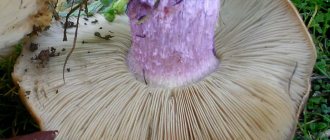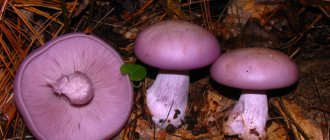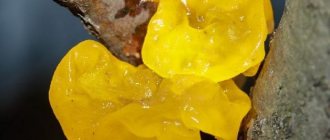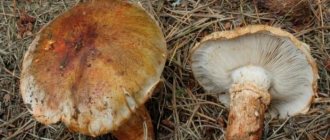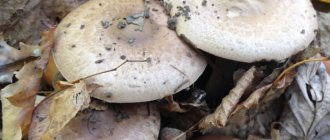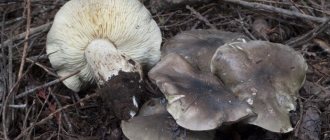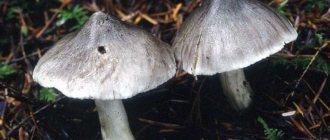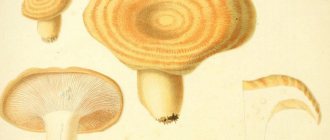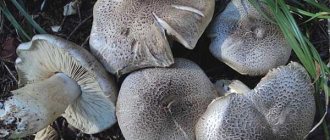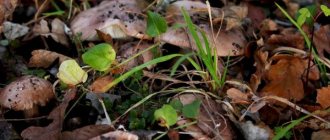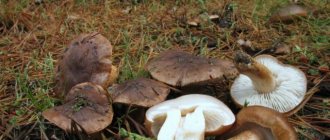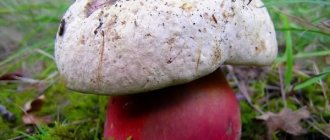An amazingly beautiful and unusual mushroom, Violet row, repels some lovers of quiet hunting with its outlandish appearance and completely in vain! Despite belonging to the 4th group of edibility, Lepista is very tasty, healthy and aromatic if prepared correctly. Find out how and when this mushroom is harvested, what is prepared from it, and how you can grow it in your own garden.
Characteristics and brief description of boron mushroom
The purple rower belongs to the genus Lepista, family Tricholomataceae (Tricholomaceae or Row). The mushroom also has other popular names: Ryadovka lilac, Lepista naked, Lepista violet, Sinyukha (cyanium), Sinichka (tit). The Latin name is Lepista nuda. A conditionally edible mushroom, the smell resembles the aroma of anise, the taste is pleasant.
The size of the naked Lepista cap ranges from 6 to 15 cm, and can sometimes reach 20 cm. In the young fruiting body it is slightly purple, then fades to a pale lilac tone with shades of brown, watery. The shape of this part is convex, hemispherical, the edge is thin, turned inward. As the mushroom matures, the cap becomes prostrate-convex, depressed, and the edges are bent. The skin is shiny, smooth, and turns pale in dry weather.
The hymenophore (lower part of the cap) is lamellar. The plates are first bright purple, then become brown-ocher, red-brown. Often located, thin, adherent or almost free. The spore powder is white, with a delicate pinkish tint. The spores themselves are ellipsoidal and colorless.
The flesh is firm and purple when cut and has a dense texture. As the mushroom matures, it becomes softer and paler. The taste is inexpressive, but pleasant.
The leg reaches a height of 4–8 cm, its thickness ranges from 1.2 to 3 cm. It has a cylindrical, sometimes club-shaped shape, with a thickening at the base. The surface is smooth, fibrous. The color of the leg when young is bright purple, becoming grayish-white with age. At the base there is purple pubescence and remains of leaves and pine needles.
How to recognize lepista?
You can recognize a row by the following characteristic features:
- Hat. In diameter from 4 to 17 centimeters. At the beginning of the life cycle, the color is bright, lilac, but over time it changes to purple and pale. A brownish tint appears. This part is flat or slightly convex in shape. The edges are uneven and curved. The structure is very fleshy and dense. It can be watery. Below you can see the gray spore-bearing organs.
- The leg has a thickening at the base. The shape is smooth and even, pleasant to the touch, but at the same time quite elastic. Because of this, the individual must be cut off with a sharp knife. Its height can exceed 10 centimeters, but this rarely happens. The color of the leg is almost identical to the upper part of the individual.
- Pulp. The structure is dense. Its color when broken is grayish-purple. Over time it softens and the color changes to cream.
- Records. Multiple, wide and very thin. Almost always free, in some cases curved. At the beginning of the life cycle, the color is very. Over time - light purple.
Tits have a persistent, inherent aroma of anise. Mushroom pickers easily distinguish this row precisely by it.
Season and place of collection
Lilac rowers prefer to grow in groups, on the soil near piles of straw or brushwood, on a litter of leaves, among thickets of nettles. Purple lepista can be found in coniferous forests and forests mixed with spruce and oak. Habitat: temperate zone of the Northern Hemisphere.
Reference! Violet row is a saprophytic mushroom that grows on fallen, rotten leaves.
Fruiting time is August-December. The peak yield occurs in September (second half) and continues until the first frost.
Growing at home and in the country
For the first time on an industrial scale, they began to grow lilac rowe in France in 1898, but the highest rates were achieved by the Dutch, who learned to cultivate blueberries on compost for champignons. That is why in our time the cultivation of this type of mushroom is similar to how champignons are produced.
Important! The row forms a fruiting body when the air temperature drops below 15 °C, that is, in autumn, winter and even spring.
The optimal time to start breeding rows is May. At their summer cottage, they are grown in beds, in bags or boxes, which are placed in the shade. Cultivation process:
- Mix the substrate with mycelium in a 2:1 ratio. Plant in the ground, cover to provide the mycelium with maximum moisture.
- After 2–3 weeks, the substrate will be covered with mycelium, after which you need to sprinkle it with damp soil (5 cm layer).
- After the same period of time, the first fruiting bodies will begin to appear. It is very important to maintain optimal soil moisture during this period. If it is dry, you need to apply an additional layer on top.
- When the temperature drops below 5 °C (if the mycelium was sown in the fall), you need to cover the ground with a cloth and lay a layer of straw on top (at least 10 cm).
How to grow purple rows indoors:
- First of all, you should choose the right place in which the tits will grow. The room should be relatively warm (10-15 ºС), humid. In addition, it must be well ventilated so that there is a sufficient volume of air, and illuminated.
- The mycelium is planted by analogy with the previous method, and the first hearth spruces will appear 3-4 months after planting.
Important! Don’t forget to fill the soil with fresh, damp soil after each harvest!
Chemical composition
The chemical composition includes many useful substances.
| Vitamins: | Minerals: |
| vitamin C – 2 mg | selenium - 0.0093 mg |
| thiamine - 0.08 mg | manganese - 0.047 mg; |
| riboflavin - 0.4 mg | copper - 0.3 mg |
| vitamin K1 - 0.001 mg | calcium - 3 mg |
| vitamin D - 0.000175 mg | iron - 0.5 mg |
| nicotinic acid - 3.6 mg | magnesium - 9 mg |
| pantothenic acid - 1.4 mg | phosphorus - 86 mg |
| vitamin B6 - 0.1 mg | potassium - 318 mg |
| folates - 0.017 mg | sodium - 5 mg |
| folic acid - 0.017 mg | zinc - 0.5 mg |
| choline - 17.3 mg | |
| betaine - 9.4 mg | |
| vitamin E - 0.01 mg | |
| tocopherol, beta - 0.01 mg | |
| tocopherol, gamma - 0.01 mg | |
| tocopherol, delta - 0.01 mg | |
| tocopherol, alpha - 0.05 mg |
The calorie content of the row is very low (22 kcal). Per 100 g of product:
- proteins - 3 g;
- fats - 0.3 g;
- carbohydrates - 3.26 g;
- ash - 0.8 g;
- dietary fiber - 1 g;
- water - 91.4 g.
False doubles
The violet row, despite its unusual color and appearance, has doubles, which are worth knowing about when going into the forest. Even experienced silent hunters can confuse this species. To correctly distinguish the variety, you should pay attention to the photo or study the table.
| Name of the mushroom | Differences | Places of growth | Edibility |
| Lepista lilac (bluefoot), Lepista saeva | Light, almost snow-white hat, purple leg. It is often called false violet row. | Zones with a subtropical climate. It grows from mid-winter until the first frost. | Conditionally edible |
| Violet lepista, Lepista irina | The mushroom is characterized by a whitish or pinkish-brown shade of the cap. In the center it is much darker than at the edges. This part is convex, with an uneven edge. The pulp has a bright violet color, which does not go away even after careful heat treatment. | Dense forest stands of temperate climate. Growing time: September – second half of November. | Conditionally edible |
| Lilac varnish, Laccaria amethystina | It has more miniature parameters, the diameter of the cap is only 5 cm. In young specimens it is convex, then becomes flatter. The leg is thin and even, it has a bright, uniform purple hue, but with age it fades and becomes paler. The pulp is also brightly colored, purple, and uniform in color. | Wet soils of the temperate climate zone. It grows from the second half of June until late autumn. | Conditionally edible |
| Purple web spider, Cortinarius violaceus | The cap is convex, with curled edges, or lowered and straight in adulthood. It has a brownish or slightly purple tint, evenly distributed throughout the fruiting body. The plates are sparse, dark purple in color. The pulp has the same color, but as the mushroom ages, it may fade. | Deciduous and coniferous forests, grows in early August - second half of September. | Conditionally edible, listed in the Red Book. |
| White-purple web spider, Cortinarius alboviolaceus | Round-bell-shaped or convex cap with an uneven surface. Its diameter is 4–8 cm. The stem is thin, up to 8 cm. The color of the mushroom is lilac-silver, pale lilac. The pulp is thick, soft, and watery in the stem. Has a characteristic musty odor. | Forests in temperate climate zones, growing time - late August - October. | Inedible |
| Goat's web spider, Cortinarius traganus | A hemispherical hat with rolled edges. Its diameter is 6–12 cm. The leg is thick and short, about 7–10 cm long, and has a bright violet-gray tint. The pulp is thick and has a strong unpleasant odor that does not disappear even after heat treatment. | Coniferous and mixed forests of temperate climate. Grows from July to early October. | Poisonous |
| Mycena pure, Mycena pura | Compared to the purple row, it is more miniature. The cap is wide-conical, hemispherical, its diameter is 4 cm, the stem is thin, up to 9 cm in height. The color is pale grayish, the edges are translucent, with stripes. The pulp is thin and watery, gray in color, and when broken it releases a lot of liquid. The fungus has a strong, unpleasant odor. | Temperate forests. It grows from early spring until the second half of July. | Inedible |
Assessment of taste qualities, benefits and possible harm
When preparing and storing tits, it is important to remember that despite their external attractiveness, this is still a conditionally edible mushroom that can be poisoned if not prepared correctly.
Violet row contains a large amount of vitamins B1 and B2, manganese, zinc and copper. It also contains ergosterol (provitamin D2) and stearic acid. Calorie content of cyanosis - 19 kcal/100 g.
The medicinal properties of Lepista glabra are widely used in pharmaceuticals. Antibiotics and antifungal drugs are made from this species.
The ability of violet row to reduce glucose levels is known, which is actively used for the manufacture of drugs to control hyperglycemia. Titmouse supports the immune system and has anti-inflammatory properties.
The harm of rowing lies in the possibility of confusing it with poisonous species. In addition, it is forbidden to consume mushrooms for children under 9 years of age, pregnant and lactating women, and people with diseases of the gastrointestinal tract.
Important! You cannot pick mushrooms near roads, highways, or near large enterprises. Fruiting bodies have the ability, like sponges, to absorb harmful microelements.
Is the violet row edible or not?
The mushroom is edible, but some sources consider it conditionally edible. Because if you eat it raw, it may cause stomach problems. Therefore, you should definitely boil it for 15–25 minutes. Then be sure to drain the water in which they were boiled. Boiling also removes the unpleasant smell and taste.
Cooking recipes
Before pickling, frying, pickling, or preparing in any other way, you must soak the peeled mushrooms for a period of 12 to 72 hours.
Then you should boil them twice in salted water. Only then can you be sure that the tits will be beneficial and tasty.
Primary processing
It must be remembered that purple rows should not be eaten raw. After collecting mushrooms, you need to carefully sort them to once again make sure that they are safe. Then you should get rid of damaged specimens, remove wormholes, and rinse them from debris and sand. Next, the mycelium is cut off and the fruiting body is completely cleaned.
Reference! Rows collected in the forest may taste bitter - this is a consequence of the fruit growing on substrates rich in resinous substances.
Cooking
The harvested, peeled crop should be placed in a deep container with water and kept for 2-3 days. During this period, you need to change the fluid to fresh one 2-3 times. Next, the mushrooms are boiled.
To do this, dissolve 1 tablespoon of salt in 1 liter of water, place the fruiting bodies and cook for 15–20 minutes. Drain the liquid, add new one and cook for the same amount.
You can add spices, bay leaves, peppercorns, and cloves to taste.
Important! Under no circumstances should you use a decoction of the rows as food. It is not only very bitter, but also harmful to health, as it contains all the toxic substances from mushrooms.
Pickling
The peculiarity of this preparation lies in its unusual appearance: pickled purple rows in a jar look very interesting. In addition, this is an excellent appetizer for any table in the winter.
Ingredients:
- water – 1 l;
- titmouse - 3 kg;
- salt – 50–60 g;
- sugar – 70 g;
- vinegar – 100 ml;
- allspice black pepper – 5 peas;
- bay leaf – 5 pcs.
How to pickle rows:
- Place the peeled and soaked fruiting bodies in a deep container and fill with water.
- Boil over medium heat for 20 minutes, constantly skimming off the foam. To prevent the fruits from losing their appearance and color, you can add a pinch of citric acid to the water.
- Place the rows in a colander, after rinsing them under cold water.
- Pour 2 liters of water into a saucepan, place the tits, and bring to a boil.
- Add spices, salt, sugar, vinegar, cook for another 20 minutes over low heat.
- Place the workpiece in sterilized jars, pour boiling marinade, and seal with plastic lids.
- Store in a cool, dark place.
Freezing
Violet lepista can be prepared for the winter by freezing.
To do this, the fruiting bodies are soaked, boiled twice in salted water, and drained in a colander to remove excess moisture.
Then the mushrooms are cut into small pieces, placed in containers or other containers for freezing and sent to the refrigerator.
Important! Divide the tits into small portions so that in winter you do not need to defrost the entire harvest.
Frying
This method is universal and suitable for any type of mushroom. Before frying purple rows, you must soak them and boil them twice, otherwise the finished dish will be hopelessly spoiled.
Ingredients:
- onion – 1 head;
- mushroom – 600 g;
- sour cream – 2 tbsp. l.;
- vegetable oil – 40 ml;
- salt, pepper - to taste.
Cooking method:
- Pre-soaked and boiled tits need to be cut into strips or in another way.
- Fry the mushrooms in vegetable oil until they are browned.
- Add peeled and finely chopped onion to the pan and cook for another 10 minutes.
- At the end of cooking, season with spices, add sour cream, and add salt.
- Cook the fried mushrooms for a couple more minutes with the lid closed.
Hot and cold salting
When pickling any mushrooms, two methods are used: hot and cold. They are both good, but the first one saves time, and the second one preserves the crunchiness of the mushrooms.
The hot salting method consists of the following steps:
- Soaked and boiled purple rows are laid out in layers in a container for salting. In this case, the caps should point down.
- Each layer is sprinkled with a small amount of salt and spices. You can add garlic, onions, herbs, etc. to taste.
- This is done until the mushrooms are gone; they should be the last layer.
- Salt the rows, set the pressure.
- Store the container in a cool place. After 10 days you can take a sample.
How to pickle using the cold method:
- Thoroughly clean the cyanosis from sand and dirt.
- Rinse the container in which the workpiece will be stored thoroughly.
- Place the mushrooms in it in several layers, sprinkling each layer with salt and spices.
- Line the top with a clean cloth, cover with a lid and place pressure.
- The product will be ready for use in a month.
Drying
It is best to dry purple rows in the oven. First, the mushrooms are cut into small slices, then laid out in one layer on a baking sheet lined with parchment.
Turn on low heat (the temperature in the oven should not exceed 50–70ºС), cook for 1 hour. The fruiting bodies should be turned over every 15–20 minutes to prevent them from burning.
Important! A properly dried mushroom has an elastic structure; it does not crumble, but does not release juice.
Canning for the winter in jars
Try making delicious, aromatic salted titmouse with carrots. This unusual dish will especially delight you in winter.
Components:
- rows - 1.5 kg;
- wine vinegar – 250 ml;
- water – 300 ml;
- carrots – 1 pc.;
- tarragon, bay leaf - 2 pcs.;
- salt – 2 tsp;
- sugar – 1 tsp.
Cooking method:
- Cleaned and pre-soaked mushrooms should be placed in boiling water and blanched for 5 minutes.
- Drain the liquid and place the blues in a colander.
- Peel the onions and carrots and simmer in wine vinegar for 15–120 minutes. Add herbs and spices.
- Place the rows in the same mixture and cook for 5 minutes.
- Place the mushrooms in sterilized, clean jars.
- Boil the marinade with vegetables for another 10 minutes, pour it over the rows.
- Seal with lids and store.
Caviar
This tasty, aromatic product will be very useful to you during the cold season. Caviar can be served as an independent appetizer or added to any side dish.
Ingredients:
- titmouse - 1 kg;
- onions – 2 pcs.;
- garlic – 5–6 cloves;
- sunflower oil – 3 tbsp. l.;
- salt – 1–2 tbsp.
Cooking method:
- Clean, soak and boil the tits twice in salted water.
- Peel and fry finely chopped onion in vegetable oil until golden brown.
- Add the mushroom to the pan and fry everything together for another 20–30 minutes.
- A few minutes before the end of cooking, add chopped garlic, spices, and salt.
- Cool the mixture and puree it using a blender.
- If you plan to store the product for the winter, then simmer the caviar for another 5–7 minutes, then place it in clean, sterilized jars.
- Pour 1 tablespoon of vinegar on top of each container and seal.
Soup
To prepare a delicious, rich lepista soup, you will need ordinary vegetables and a few spices. Serve this aromatic dish with white bread croutons.
Ingredients:
- chicken fillet – 1 pc.;
- rows – 500 g;
- onion – 2 heads;
- potatoes – 3 pcs.;
- carrots, sweet pepper – 1 pc.;
- vegetable oil – 1 tbsp. l.;
- salt pepper.
How to cook:
- Make chicken stock: Place chicken in a saucepan of cold water and simmer for 30-40 minutes.
- Cut the soaked and boiled rows into thin strips and place in the broth.
- Peel the potatoes, cut into cubes, add to the soup. Cook for 10 minutes.
- Peel the bell pepper, onion, and carrots, cut into thin strips and fry in sunflower oil.
- Combine all ingredients, season with salt and pepper, cook for 10–15 minutes until fully cooked.
Salad
This dish is easy and simple to prepare, but you need to make the pickled rows in advance using any of the methods described above.
Ingredients:
- blues - half a kilogram;
- canned peas – 100 g;
- green onions – 50 g;
- mayonnaise or sour cream for dressing.
Cooking method:
- Finely chop the green onions.
- Place the marinated mushrooms in a colander to drain excess liquid.
- Mix all ingredients in a deep container, season with sour cream or mayonnaise, add salt.
Useful tips
Tip #1
Purple titmouse can be prepared for the winter by freezing it in the freezer. To do this, soak the mushrooms, boil them twice in salted water and pour into a colander. When the bluelegs are completely dry, cut them into halves or slices, place them in tight bags or plastic containers and store them in the freezer.
Tip #2
Bluelegs can be dried for future use. To do this, cut the soaked and boiled mushrooms into pieces, place them in a thin layer on a baking sheet and place them in the oven for 1 hour, preheated to 60-70°C.
